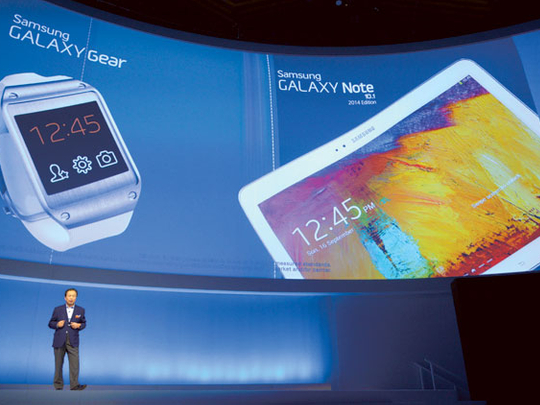
San Francisco: Samsung’s launch of its Galaxy Gear smartwatch was trailed as a new beginning for wearable technology after a decade of false starts.
“Our time is a time for crossing boundaries,” gushed Pranav Mistry, head of Samsung’s “think tank”, as he showed off the device in Berlin on Wednesday. “Welcome to the future.”
Sony has already launched a smartwatch, albeit to mixed reviews, and Apple, Google and LG are all working on devices of their own. Mobile chipmakers such as Qualcomm and Broadcom are championing the technology as the next big thing and venture capitalists are investing tens of millions of dollars in hardware start-ups.
However, initial reaction to the Galaxy Gear from analysts and gadget reviewers on Wednesday was decidedly mixed, just as Google’s Glass headset has suffered a recent backlash from privacy campaigners and fashionistas alike.
Despite all the wearables hype, consumers’ appetite for bulky, $300 devices that require frequent recharging and replicate many of their smartphones’ functions is still far from proven.
Sarah Rotman Epps, analyst at Forrester Research, said the Gear improved on its predecessors - from 2003’s Microsoft Spot watch to last year’s Kickstarter-funded Pebble - but “still doesn’t give consumers a convincing reason to buy one”.
“Samsung is pursuing a spaghetti-on-the-wall product strategy: Launch a smartwatch and maybe it will stick,” she wrote in a blogpost on Wednesday.
“My bet is that smartwatches are sci-fi inventions that are already anachronisms in this modern world.”
Chetan Sharma, a mobile industry consultant, said on Twitter that smartwatches were “the netbooks of 2013” — a reference to the shortlived popularity of cheap, low-powered laptops that were quickly superseded by tablets such as the iPad.
Studies show that consumer awareness of wearable gadgets is high but purchase activity is low.
A survey of over 1,500 smartphone owners in the US and UK by On Device Research for analyst firm CCS Insight found that 65 per cent of respondents had heard of smartwatches and almost half of Americans surveyed had heard about Google Glass. “This is very high for a product that isn’t even commercially available at the moment,” said Siim Teller, marketing manager at On Device Research.
However, while 20 per cent said they would buy, give or receive a smartwatch by Christmas, fewer than 5 per cent own such a device today - and of those who do, more than a third were no longer using it.
“There is an interaction issue that is very challenging” with wrist-based computing, said Robert Brunner, founder of San Francisco design agency Ammunition Group, which has worked on the popular Beats by Dr Dre headphones and 2011’s Wimm smartwatch, which was acquired by Google last year after underwhelming sales.
“There’s a certain size of thing that people will put on their arm - it’s a small piece of real estate,” Mr Brunner said, limiting what the device can do.
The Galaxy Gear offers touchscreen controls as well inbuilt motion sensors for gesture controls, as well as the ability to issue voice commands to a Bluetooth-tethered smartphone. That usability, alongside a colour screen, makes it more sophisticated than most of its predecessors, but battery life of just 25 hours and relatively large size may limit its appeal.
“It clearly puts the wearables business into second gear,” said Christian Lindholm, a former Nokia designer now developing wearable technology at his start-up, Koru. But he believes that curved screens will be the “tipping point” for smartwatches that touchscreens were for smartphones. Both Apple and Samsung have already filed patents for putative devices with curved displays.
Strategy Analytics, a research group, predicts that 15m wearable devices will be sold globally in 2013, rising to 75m by 2017: a small fraction of the smartphone market, which already runs into hundreds of millions of units every year.
Others are more optimistic.
“My intuition is that this is going to be a very big market in the next five years,” said Broadcom’s chief executive, Scott McGregor, with many wearable-tech start-ups likely to flourish, in contrast to the handful of large companies that dominate smartphones. “The initial investment will be much lower, which will enable a huge growth of innovation like we haven’t seen in a while. Some will be cool, some will be left in a drawer.”
Amit Daryanani, hardware analyst at RBC Capital Markets, estimates that up to 30 per cent of today’s 850m smartphone owners might buy a connected device within 18 months, by which time the iWatch and others are expected to launch.
“The potential of this is phenomenal,” he said. “If I had to predict the next breakthrough product, it’s absolutely wearable technology.”
— Financial Times










